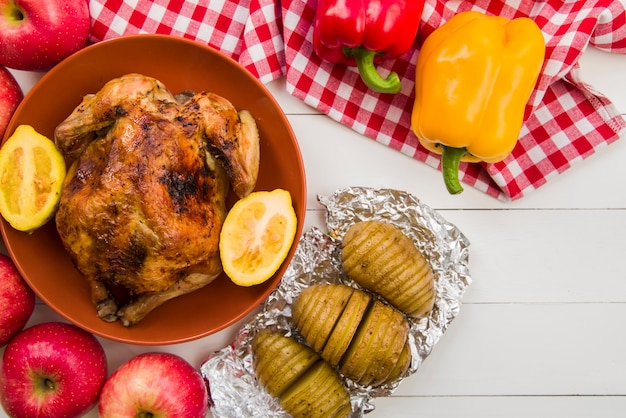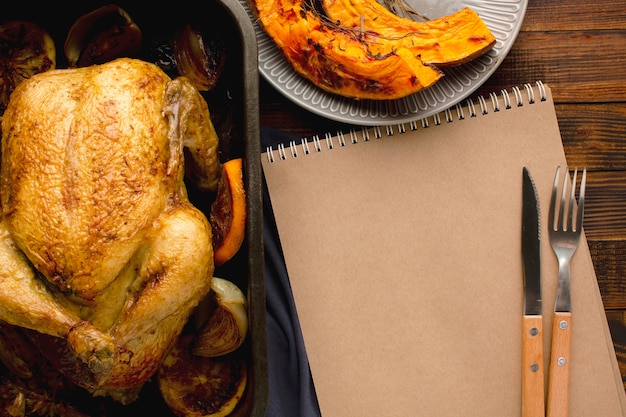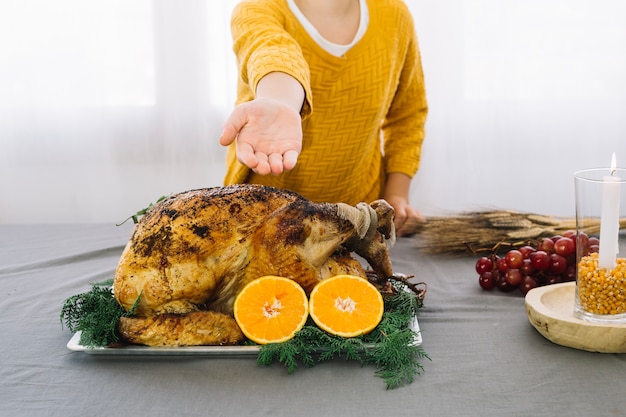(Part 1) Remembering My First Turkey

(Part 2) The Factors That Shape Your Turkey’s Fate

Size Matters – A Lot
It's pretty obvious, but a larger turkey requires a longer cooking time. Your 16-pound turkey is going to need more time in the oven than a 10-pounder. Remember, heat needs to penetrate the entire bird, and that takes time.Oven Temperature – Finding the Sweet Spot
Oven temperature is critical. High temperatures might cook your turkey faster, but they also run the risk of burning the outside before the inside is cooked through. On the other hand, low temperatures cook more slowly, allowing the heat to penetrate evenly. The goal is to strike a balance, to cook the turkey through without drying it out. The standard recommendation for turkey roasting is 325°F (160°C). This temperature provides a good balance of heat and time for a well-cooked turkey.Stuffing – To Stuff or Not to Stuff, That is the Question
Stuffing can add a wonderful flavor element to your turkey, but it also presents a bit of a challenge. Stuffing needs to reach an internal temperature of 165°F (74°C) to be safe to eat. If you choose to stuff your turkey, keep in mind that it will take longer to cook, as the stuffing needs to reach that critical temperature. And make sure to cook the stuffing separately if you're worried about undercooked stuffing.Thawing Time – Be Patient, My Friend
If you're working with a frozen turkey, patience is key. You absolutely need to thaw it before cooking. The general rule of thumb is to allow 24 hours of thawing time for every 5 pounds of turkey. So, for your 16-pound turkey, you'll need about 3 days of thawing time.Thawing a turkey properly is essential for ensuring it cooks evenly and safely. Don't try to rush the process, as it could lead to uneven cooking and foodborne illness. There are a few safe ways to thaw a turkey:- Refrigerator: This is the safest and most recommended method. Place the turkey on a tray in the refrigerator and allow it to thaw slowly. It takes about 24 hours for every 5 pounds of turkey.
- Cold water bath: Submerge the turkey in a container of cold water, changing the water every 30 minutes. Make sure the turkey is fully submerged in water. This method is faster than thawing in the refrigerator but requires more attention and supervision.
- Microwave: Some microwaves have a defrost setting, but it's not ideal for large turkeys. It can lead to uneven thawing and could potentially cook parts of the turkey before it's completely thawed.
(Part 3) Calculating Cooking Time – A Rough Guide

| turkey weight (pounds) | Cooking Time (hours) |
|---|---|
| 10-12 | 3-3.5 |
| 12-14 | 3.5-4 |
| 14-16 | 4-4.5 |
| 16-18 | 4.5-5 |
| 18-20 | 5-5.5 |
(Part 4) Prepping the Turkey – A Culinary Ritual
Before you put your turkey in the oven, there are a few essential steps you need to take to ensure a delicious and safe outcome.Pat It Dry – Getting the Skin Ready to Shine
The first step is to pat the turkey dry with paper towels. This helps the skin crisp up nicely, achieving that golden-brown perfection we all crave.Seasoning – A Symphony of Flavors
Now it's time to unleash your inner chef and season your turkey. There's no right or wrong way to season a turkey – it's all about personal preference. I often use a simple blend of salt, pepper, and paprika. But feel free to experiment with other spices like garlic powder, onion powder, sage, thyme, or rosemary. You can even create your own custom blend!Taming the Wings – Keeping Them in Check
To prevent the wings from burning, tuck them behind the back of the turkey. This keeps them out of the direct heat and ensures even cooking.Tying the Legs – Creating a Unified Front
Tie the legs together with kitchen twine to keep the turkey compact and encourage even cooking. This helps prevent the legs from drying out and allows the heat to penetrate the entire bird more evenly.(Part 5) The Oven – Your Turkey's Sanctuary
Now that your turkey is prepped, it's time to send it to its culinary haven – the oven!Preheat your oven to 325°F (160°C). Place the turkey in a roasting pan, making sure it's large enough to accommodate the bird comfortably. Add about 1/2 cup of water to the bottom of the pan. This creates steam and helps keep the turkey moist. You can also add a few vegetables, like carrots, onions, and celery, to the pan for added flavor.
Now, it's time to put your turkey in the oven. Place the pan in the center of the oven and let the roasting begin. This is where patience comes in – you need to give the turkey the time it needs to cook through. Don't open the oven door too often, as this can cause the temperature to drop and extend the cooking time.
(Part 6) Checking for Doneness – The Art of the meat thermometer
Remember, the estimated cooking time is just a guide. The most accurate way to ensure your turkey is cooked through is to use a meat thermometer.Insert the thermometer into the thickest part of the thigh, making sure it doesn't touch any bone. The turkey is done when the internal temperature reaches 165°F (74°C) in the thigh. You can also check the breast, which should reach 165°F (74°C) as well.
Don't rely on the pop-up timer that comes with some turkeys. These timers are not always accurate and can pop up before the turkey is cooked through. Always use a meat thermometer to ensure the turkey is safe to eat.
(Part 7) Resting the Turkey – A Moment of Indulgence
Once the turkey is cooked through, it's time for a crucial step that often gets overlooked: resting. Allow the turkey to rest for about 15-20 minutes before carving.This resting period is essential for allowing the juices to redistribute throughout the meat. The result? A more succulent and flavorful turkey. Transfer the turkey to a cutting board and loosely cover it with foil. While the turkey rests, you can prepare your gravy and the rest of your feast.
(Part 8) Carving the Turkey – A Moment of Triumph
After all the anticipation and preparation, it's time for the grand finale – carving the turkey. This is your moment to shine, to unveil the masterpiece you've created.Use a sharp carving knife and a cutting board. Start by removing the legs and thighs. Then, carve the breasts into slices, working your way down the length of the breastbone. If you're feeling fancy, you can carve the breasts into fancier shapes, like medallions or strips.
Arrange the carved turkey on a platter, surround it with your favorite sides, and pour the gravy over it. You've done it! You've cooked a delicious and beautiful turkey!
(Part 9) Tips and Tricks – The Secrets of Success
Here are a few extra tips to help you avoid any turkey-related mishaps:- Don't overstuff the turkey: Overstuffed turkeys take longer to cook and could be undercooked in the center. If you must stuff the bird, use a stuffing recipe that is meant to be cooked separately.
- Basting is optional: While basting the turkey with pan juices can help keep it moist, it's not essential. I personally prefer to let the turkey cook uncovered, as this helps the skin crisp up nicely.
- Beware of the pop-up timer: Don't rely on the pop-up timer to tell you when the bird is done. The timer is not always accurate and can pop up before the turkey is cooked through. Always use a meat thermometer to check the internal temperature.
- Don't overcrowd the oven: If you're cooking multiple dishes at the same time, make sure there's enough space in the oven for the heat to circulate properly.
(Part 10) Troubleshooting – When Things Don’t Go as Planned
Sometimes, even the best-laid plans can go awry. Here's what to do if your turkey isn't cooperating:- If the turkey isn't cooked through: If the turkey isn't cooked through after the recommended time, it may need to cook for a little longer. Check the internal temperature every 15 minutes until it reaches 165°F (74°C).
- If the turkey is browning too much: Cover the turkey loosely with foil to prevent it from burning.
- If the turkey is dry: Add a little bit of butter or broth to the roasting pan to help keep it moist.
FAQs
Q: How long do I cook a 16-pound turkey at 350°F?
A: At 350°F, a 16-pound turkey will take about 3-3.5 hours to cook. However, always check the internal temperature with a meat thermometer to ensure the turkey is cooked through. Remember, the higher temperature will cook the bird faster, so you might need to adjust your cooking time a bit.
Q: Can I cook a turkey in a slow cooker?
A: You can cook a turkey in a slow cooker, but it's not the most ideal method. A slow cooker cooks food at a low temperature, and it can take a very long time to cook a whole turkey. If you're using a slow cooker, you'll need to cook the turkey on low for 6-8 hours, or on high for 3-4 hours. Be sure to check the internal temperature to ensure the turkey is cooked through. Keep in mind that the skin might not get as crispy as in a conventional oven.
Q: What should I do with the leftover turkey?
A: Leftover turkey is a culinary treasure! You can use it to make sandwiches, salads, soups, or even turkey pot pie. You can also freeze it for later. To freeze turkey, wrap it tightly in plastic wrap and aluminum foil and freeze it for up to 2 months.
Q: What's the best way to carve a turkey?
A: The best way to carve a turkey is to start by removing the legs and thighs. Then, carve the breasts into slices, working your way down the length of the breastbone. Be sure to use a sharp carving knife and a cutting board. You can also use a turkey carving fork to help stabilize the bird.
Q: Is it safe to eat turkey that has been left out at room temperature for a few hours?
A: No, it's not safe. Bacteria can grow rapidly at room temperature, so it's important to keep cooked turkey refrigerated. Cooked turkey should be refrigerated within 2 hours of cooking. It's also best to use a meat thermometer to check the internal temperature of the turkey to ensure it's cooked through before serving.
Everyone is watching

Prime Rib Roast Cooking Time Chart: Per Pound Guide
Cooking TipsPrime rib roast. Just the name conjures images of lavish dinners, crackling fires, and hearty laughter. It’s ...

How Long to Bake Potatoes in the Oven (Perfect Every Time)
Cooking TipsBaked potatoes are a staple in my kitchen. They're incredibly versatile, delicious, and surprisingly easy to m...

Perfect Rice Every Time: The Ultimate Guide to Cooking Rice
Cooking TipsAs a self-proclaimed foodie, I've always been a bit obsessed with rice. It's the foundation of countless cuisi...

The Ultimate Guide to Cooking Asparagus: Tips, Techniques, and Recipes
Cooking TipsAsparagus. The mere mention of this spring delicacy conjures up images of vibrant green spears, crisp and burs...

Ultimate Guide to Cooking the Perfect Thanksgiving Turkey
Cooking TipsThanksgiving. Just the word conjures up images of overflowing tables laden with delicious food, the scent of r...
